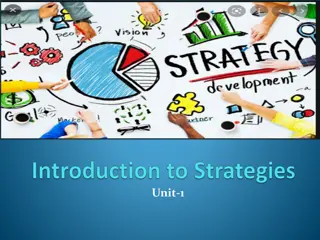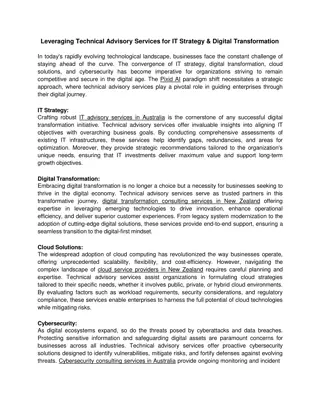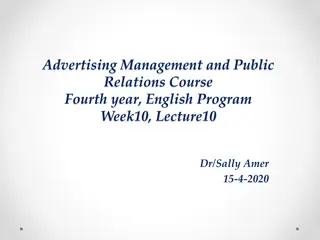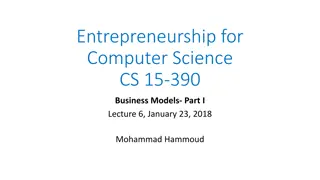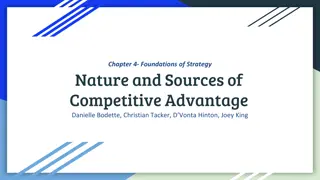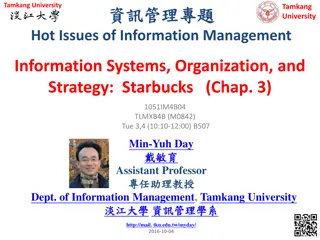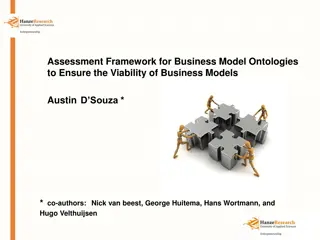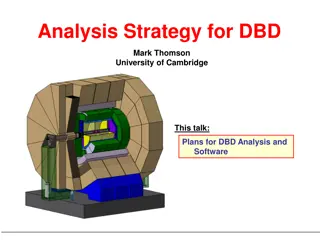Understanding Business Strategy: Competitive Analysis and Models
This chapter focuses on organizational strategy, competitive advantage, and information systems. It covers key concepts such as business strategy, Michael Porter's Five Forces model, value chain, SWOT analysis, and strategies for gaining a competitive edge. Furthermore, it explores how to build Strategic Information Systems (SIS) to enhance business performance.
Download Presentation

Please find below an Image/Link to download the presentation.
The content on the website is provided AS IS for your information and personal use only. It may not be sold, licensed, or shared on other websites without obtaining consent from the author. Download presentation by click this link. If you encounter any issues during the download, it is possible that the publisher has removed the file from their server.
E N D
Presentation Transcript
CHAPTER 2 ORGANIZATIONAL STRATEGY, COMPETITIVE ADVANTAGE, AND INFORMATION SYSTEMS
CHAPTER OBJECTIVES Define what strategies and business strategies are Explain what is Michael Porter s Five Force model, value chain and SWOT analysis Identify basic strategies for gaining a competitive advantage Explain how to build SIS
TERMINOLOGIES What is business? A business is an organization that strives for a profit by providing goods and services desired by its customers. Businesses meet the needs of consumers by providing medical care, autos, and countless other goods and services. Goods are tangible items manufactured by businesses, such as laptops. Services are intangible offerings of businesses that can t be held, touched, or stored. Physicians, lawyers, hairstylists, car washes, and airlines all provide services. Businesses also serve other organizations, such as hospitals, retailers, and governments, by providing machinery, goods for resale, computers, and thousands of other items. What is strategy? Strategy is a framework or approach to obtain an advantageous position What is business strategy? A plan to help an organization to gain advantages over its competitors and achieve specific set of goals
METHODS TO SHAPE BUSINESS STRATEGY MICHAEL PORTER S FIVE FORCES MODEL (EXTERNAL ANALYSIS) Video Link for Michael Porter s five forces model
FIVE FORCES MODEL (CONTINUED) Buyers Power- the ability of buyers to affect the price of an item Switching Cost- Costs that make customers to switch from one product (or service) to another product (or service) Loyalty Program- Programs that encourage customers to make purchases more frequently
FIVE FORCES MODEL (CONTINUED) Supplier Power- the suppliers ability to influence the prices they charge for supplies Supply chain the network used to deliver products and services from raw materials to end customers through an engineered flow of information, physical distribution, and cash. Manufactures Suppliers of Supplier Suppliers Customers
FIVE FORCES MODEL (CONTINUED) Threat of Substitute The threat is high when they are many alternatives to a product or service and low when there are few alternatives
FIVE FORCES MODEL (CONTINUED) Threat of new entrants The threat is high when it is easy to enter a market for new competitors and low when there are high entry barriers. Entry barriers: the hindrances that make it difficult and high cost to enter a given market.
FIVE FORCES MODEL (CONTINUED) Rivalry among existing competitors: the competition is high when many competitors are in a market and low when competitors are a few. Niche market: the subset of the market on which a specific product or service is focused Product differentiation: develops unique differences (price, feature, design, etc.,) in its products or services with the intent to increase demand.
METHODS TO SHAPE BUSINESS STRATEGY SWOT ANALYSIS (INTERNAL ANALYSIS) SWOT Analysis: an analysis of the strengths, weaknesses, opportunities, and threats of and to an organization. Starbucks SWOT Analysis
METHODS TO SHAPE BUSINESS STRATEGY INDUSTRY VALUE CHAIN BY MICHAEL PORTER Value Chain: a set of activities that an organization carries out to create value for its customers. Value chain analysis: an examination of all links (suppliers, manufacturers, transporters, distributors, and retailers) a company uses to produce and deliver its products and services starting from the origination point and continuing through delivery to the final customer. A successful value chain analysis can lead to lower operational cost, more competitive prices, greater operational efficiencies and adding value for customers. Video for Porter s value chain model
PORTER'S VALUE CHAIN MODEL (CONTINUED) Primary value activities Inbound logistics Operations Outbound logistics Marketing and sales Service
PORTER'S VALUE CHAIN MODEL Support value activities Firm infrastructure Human resource management Technology development Procurement
INTEGRATE INFORMATION SYSTEMS FOR COMPETITIVENESS AND ORGANIZATIONAL SUCCESS
CREATING AN STRATEGIC INFORMATION SYSTEMS All levels of management must be involved throughout the whole development process Strategic information systems must be a part of the organizational strategic plan Cost and financial benefits of creating SIS should be estimated. Although it is difficult
SAMPLE QUESTIONS FOR CREATING SIS What is the risk of not developing such a system? Can an information systems developed provides competitive advantage over the competitors? What is the advantages and disadvantages of a new SIS compared with the one currently have? Will the new SIS add value to the customer s experience? If so, how ? How long will it take to build SIS? How much will it cost? how long will it take the competitors to build similar system?



